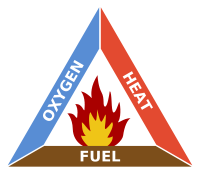
Photo from wikipedia
Assessing the fire risk of vegetated roofs includes the determination of their possible contribution to fire. Green roof components such as plants and growing media are organic materials and present… Click to show full abstract
Assessing the fire risk of vegetated roofs includes the determination of their possible contribution to fire. Green roof components such as plants and growing media are organic materials and present a fuel that can catch and support the spread of fire. The flammability characteristics of these components were analyzed and compared to a typical roof covering. Growing media with 15% of organic matter were tested using cone calorimeter apparatus. The fuel load and heat release rate of the growing media were measured in both moist (30%) and dry conditions. It was observed that growing media in a moist condition do not present a fire risk, reaching a maximum heat release rate of 33 kW/m2. For dry substrates, a peak heat release rate of 95 kW/m2 was recorded in the first minute, which then rapidly decreased to 29 kW/m2 in the second minute. Compared to a typical bitumen roof membrane, the green roof showed a better fire performance. The literature data report more severe results for plant behavior, reaching peak heat release rates (HRRs) of 397 kW/m2 for dried and 176 kW/m2 for a green material. However, a rapid decrease in HRR to much lower values occurs in less than 2 min. The results also show that extensive and intensive types of green roofs present 22% and 95% of the additional fire load density when installed on a modified bitumen membrane, 19.7 and 85.8 MJ/m2, respectively.
Journal Title: Buildings
Year Published: 2020
Link to full text (if available)
Share on Social Media: Sign Up to like & get
recommendations!